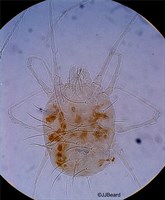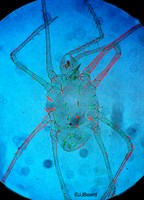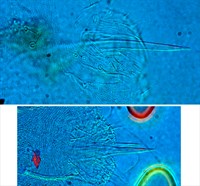Click on images to enlarge

Fig. 1. Petoriba harti adult female (non-type) - dorsal habitus.

Fig. 2. Petoriba harti adult female (non-type) - detail of ambulacrum - lateral "claws" reduced to small pad with tenent hairs and central empodium.

Fig. 3. Petoriba harti adult male (non-type) - dorsal habitus.

Fig. 4. Petoriba harti adult male (non-type) - detail of aedeagus.
Material examined
non-types
Taxonomy
Subfamily Bryobiinae
Tribe Petrobiini
Distribution
+Australia, Brazil, CIS, China, Costa Rica, Egypt, El Salvador, France, Greece, Hainan Island, Hawaii, India, Iran, Israel, Italy, Japan, Koreq, Madagascar, Madeira Island, Malawi, Mauritiana, Mauritius, Mexico, Mozambique, New Caledonia, Okinawa Island, Portugal, South Africa, Spain, Taiwan, *USA, Vanuatu
Taxonomy Changes
Neophyllobius harti Ewing 1901
Tetranychina harit (Ewing) Banks 1917
Petrobia harti (Ewing) Pritchard & Baker 1955
Petrobia (Tetranychina) harti (Ewing) Tuttle & Baker 1968
Tetranychina macdonoughi McGregor 1917, synonymy Pritchard & Baker 1955
Tetranychina tuberculata Kishida 1921, synonymy Pritchard & Baker 1955
Tenuicrus errabundus Womersley 1940, synonymy Pritchard & Baker 1955
Neobryobia spectabilis Reck 1941
Tetranychina spectabilis (Reck) Reck 1948
Petrobia spectabilis (Reck) Reck 1959, synonymy Pritchard & Baker 1955
Tetranychina agerati Sayed 1946, synonymy Pritchard & Baker 1955
Diagnosis
Female
- dorsal setae set on tubercles (Fig. 1)
- dorsal setae are much longer than distance to next seta
- peritreme ends in short hook like golfclub, and does not protrude
- dorsal setae f1 shorter than other setae inserted medially on dorsum
- leg I is twice length of body (Fig. 1)
- empodium (claw-like) as long as tenent hairs on lateral claws (pad-like) (Fig. 2)
Male
- legs I & IV are three times the length of the body (Fig. 3)
- aedeagus almost straight, tapering evenly along length to sharp point distally (Fig. 4)
Hosts
*type host unknown
> 40 recorded species of host plant, including: Ageratum conyzoides (Asteraceae), Artemisia herba-alba (Asteraceae), Artocarpus heterophyllus (Moraceae), Atropa belladonna (Solanaceae), Averrhoa carambola (Oxalidaceae), Citrus grandis (Rutaceae), Crotalaria anagyroides (Fabaceae), Fragaria sp. (Rosaceae), Ipomoea batatas (Convolvulaceae), Malus domestica (Rosaceae), Medicago sativa (Fabaceae), Mentha pulegium (Lamiaceae), Oxalis articulata, O. corniculata, O. corymbosa, O. europaea, O. latifolia, O. pes-caprae (Oxalidaceae), Pennesetum longistylum (Poaceae), Petunis hybrida (Solanaceae), Plantago lanceolata (Plantaginaceae), Saccharum officinarum, S. spontaneum (Poaceae), Solanum melongena (Solanaceae), Trifolium sp. (Fabaceae), Vitis vinifera (Vitaceae)
Biology
Petrobia harti is dark brown with light red legs.
This species occurs throughout the world on Oxalis spp. (Oxalidaceae). Dubitzki and Gerson (1987) found that Petrobia harti developed more rapidly and lived longer on Oxalis corniculata a known host, than on O. articulata which is not known as a natural host for the mite species. This species of spider mite is in greatest numbers in the field in early summer and the popluation drops right down during winter. Males are rare in this species, making up only 10% or less of field populations. The mites spend most of their time, and lay their eggs, on the ventral surface of the host leaves. Diapause in the field was not observed.
References
Banks, N. (1917) New mites, mostly economic (Arach. Acar.). Entomol. News 28: 193-199
Dubitzki, E. and Gerson, U. (1987) The natural history of Petrobia (Tetanychina) harti (Ewing) and Petrobia (Mesotetranychus) tunisiae Manson (Acari: Tetranychidae) in the laboratory. Experimental and Applied Acarology 3: 91-94
*Ewing, H.E. (1909) New species of Acarina. Trans. Am. Entomol. Soc. 35: 401-415
Kishida, K. (1921) Zool. Mag. 33: 449
McGregor, E.A. (1917) Descriptions of seven new species of red spiders. Proc. U.S. Natl. Mus. 51: 581-590
Pritchard, A.E. and Baker, E.W. (1955) A revision of the spider mite family Tetranychidae. Pacific Coast Entomology Society Memoirs 2: 1-472
Reck, G.F. (1941) New genus and species of spider mites in Georgia (Tetranychidae, Acari). Soob. Akad. Nauk Gruz. S.S.R. 2: 749-753
Reck, G.F. (1948) Fauna of spider mites (Tetranychidae, Acari) from Georgia. Tr. Zool. Inst. Akad. Nauk S.S.R. 8: 175-185
Reck, G.F. (1959) A key to tetranychoid mites. Fauna Trans. Caucasia Akad. Nauk Gruz. S.S.R. 1: 1-152
Sayed, M.T. (1946) Contribution to the knowledge of Acarina of Egypt. V. Five new species of Tetranychidae. Bull. Soc. Fouad., Ier Entomol. 30: 79-97
Tuttle, D.M. and Baker, E.W. (1968) Spider mites of South-western United States and a revision of the family Tetranychidae. Tucson, Ariz., Univ. Ariz. Press: 1-143
+Womersley, H. (1940) Studies in Australian Acarina, Tetranychidae and Trichadenidae. Transactions of the Royal Society of South Australia 64: 233-265
Notes
Womersley (1940) recorded this species in Australia under the name Tenuicrus errabundus.
There may be more than one species in Australia being referred to as P. harti. What we are calling P. harti may not be the true species.
Copyright © 2018. All rights reserved.